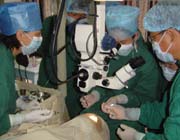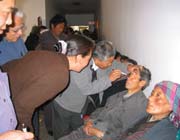Seva helps modernize cataract surgery in Tibet
As surgical techniques and equipment are updated, cost and distance become priority problems to tackle.
Tibet has one of the highest rates of blindness in the world, and cataract is the leading cause. Tibet’s high terrain and harsh climate may put people there at increased risk for cataract, but environment is only partly to blame. The high blindness rate is also attributed to poorly trained and equipped surgeons in the region, according to international blindness prevention experts.
 Tibetan patients after surgery. Image: Wilkie A |
Since 1995, the Seva Foundation has worked with hospitals in the Tibetan region to train surgeons there and supply them for cataract surgery. The foundation has assisted in creating eye departments at the major prefectural hospitals in Tibet and is working to reduce the rate of blindness by improving the quality and volume of cataract surgery. Seva is one of several nongovernmental organizations in the area working to reduce the high blindness rate through surgical training programs.
Chundak Tenzing, MD, medical director of the Seva Foundation, and colleagues started the Tibetan program with a fact-finding mission to determine where Seva could serve best.
“We found out that they had a lot of buildings, a lot of people working, good road conditions, but the technique of cataract surgery was mostly intracapsular cataract surgery,” he told Ocular Surgery News.
As a result, many people wore heavy cataract glasses, which were frequently lost or broken, making them once again functionally blind, said Alexa Wilkie, executive director of Seva.
Training crucial
The fact-finding mission found that many surgeons in Tibet used outdated surgical techniques that induced complications and led to poor outcomes, said Dr. Tenzing, a native of Nepal.
“They extracted the lens by heating a silica gel on a matchstick, getting it to the lens capsule and bringing it out, so sometimes the capsule broke,” Dr. Tenzing said. “We also witnessed an ancient method of cataract surgery called couching. A thick probe was inserted through the stab incision made at the limbus. The probe was swept underneath the iris and pushed against the lens in an effort to dislodge it, the forceful manuever denting the cornea.” With couching, the likelihood of a positive visual outcome is 50/50, he said. This technique also puts patients at increased risk of developing glaucoma.
In addition, there was poor hygiene in some centers, and sutures and necessary instruments such as Simcoe cannulas were not always available, Dr. Tenzing said.
The group also observed that many of the surgeons were not ophthalmic surgeons.
“It was difficult for us to understand the Chinese medical system. At the level of eye doctors, some were qualified, others were upgraded barefoot doctors or traditional medicine doctors,” Dr. Tenzing said.
He said Chinese surgeons in these areas are typically five-senses physicians, treating the eye, ear nose and throat and also practicing dentistry.
From the fact-finding mission, it was clear that surgical training would be the beginning of developing better eye care in the region, Ms. Wilkie said. Seva has since helped local counterparts to develop a 10-year plan to address cataract blindness. The plan includes implementing tracking systems to record the number of cataract surgeries performed and their outcomes, she said.
“What we need to do during the next 10 years is really build a comprehensive system from the town and village level to the prefectural level,” she said.
Ideally, Seva will help create an effective primary care system that will screen, educate and refer patients to tertiary hospitals, she said.
Survey findings
Dr. Tenzing and colleagues conducted a survey to see what problems existed with cataracts and surgery. They found a high prevalence of cataract among women and children. Often, patients, particularly women, did not even wear glasses after surgery, he said.
“Many who were pseudophakic had poor visual outcomes. The cause was not determined. It could be due to posterior opacification, postoperative astigmatism or other conditions,” he said. “Now there is more emphasis on the quality of the surgery and better postoperative management, making sure we have a better postsurgery visual recovery.”
Tibet’s high elevation and a vitamin A deficiency in the population may also predispose people to cataract, Dr. Tenzing said.
“Because Tibet is at an altitude of over 4,000 meters (more than 2 miles), it may be the UV rays at this altitude,” he said. He said Seva found vitamin A deficiency to be a public health problem, but the group did not see evidence of it in keratomalacia or take any blood samples.
Macular degeneration is the second leading cause of blindness in Tibet, and corneal opacities rank third, Dr. Tenzing said.
“Many patients work as nomads or as farmers, and they sustain injuries. Also, the hygiene is poor, which may [cause] infection. It’s a very harsh environment. There are sand and wind storms, all sorts of insults to the cornea,” Dr. Tenzing said.
Tibet eye camps
|
Image: Wilkie A |
Dr. Tenzing led the Seva Foundation in establishing eye camps and training programs in Tibet. Seva established programs in the major Tibetan provinces of Nyingchi in the east, Ngari in the west and Lhasa in the center of the region. The goal was to ensure Tibetan provinces were adequately covered for the treatment of cataract. The Seva Foundation not only challenged the outdated practice of ophthalmic medicine, but it also had to accustom its surgeons to Tibet’s high altitude and frigid temperatures, he said.
“For volunteer surgeons, I would say [the environment] is a problem. It’s cold. Hands can get numb. There are altitude problems. Surgeons are not able to function as they would in their hometown,” he said.
The Seva Foundation trains cataract surgeons, assistants and nurses to work in Tibetan hospitals at the Lumbini Eye Hospital in Nepal, where Seva started a program 25 years ago. The hospital performs around 30,000 cataract operations per year. There, surgeons are given two months of hands-on training with extracapsular extractions and posterior chamber IOL implantation. They then move on to one of Seva’s eye camps, which can care for 3,000 patients per year.
“What we have tried to do is limit the number of cataract surgical training that we provide. In one sector, we are providing, depending on the population, one or two surgeons, so they would get a lot of cataract surgery to do and be good at that,” Dr. Tenzing explained.
After training is completed, the surgeons receive an operating microscope and a year’s worth of supplies to bring to their hospital in Tibet, Dr. Tenzing said. Tibet also received a YAG laser because posterior capsular opacification is common.
Until the recent Seva-sponsored survey, there were no baseline numbers to compare how well the surgical training program is doing, Ms. Wilkie said. Newly implemented tracking systems, however, show a significant number of surgeries are being done, she said.
“We can’t give rates of improvement; those systems weren’t in place. We do know the numbers of people getting cataract surgery. We know the quality of surgery is improving,” she said.
This year, enough surgeries are being performed in Tibet for the first time to meet the incidence rate of cataract, according to a Seva survey, Ms. Wilkie said.
“Basically, we’ve built a capacity over a number of years, so it’s quite an improvement,” she said.
New problems
Seva still faces hurdles in creating an effective eye care system in Tibet.
A change in the Chinese health care system has forced more financial responsibility onto hospitals, Ms. Wilkie said. In the past, hospitals could provide free or more affordable services because of government reimbursement. Now, the government requires hospitals to recover their own costs from patient fees. This has created an additional barrier to patient access, she said.
“In Nepal, one of the poorest countries in the world, we established a financial fee structure at the Lumbini Eye Hospital. … We surveyed the economy and figured out the basis on which people could pay, even though most people could not afford much. … In general, we found that people were willing to pay 1 month’s salary for cataract surgery because it’s such an obvious economic benefit,” she said.
The Lumbini Eye Hospital now has a sliding fee scale, which has helped it reach the goal of being self-sufficient. Ms. Wilkie said Seva hopes to apply the same idea to the Tibetan hospitals.
Transportation is also a problem. In a vast region that is sparsely populated, there is little public transportation and few private vehicles, she said.
“At a certain level, you still need to bring services to the patient, and that’s one thing we don’t have right now. We’d like to have screening camps and bring cataract patients back for treatment. The financial barriers and the distance are two of the biggest challenges right now,” Ms. Wilkie said.
For Your Information:
- Chundak Tenzing, MD, and Alexa Wilkie can be reached at the Seva Foundation, 1786 Fifth St., Berkeley, CA 94710; 510-845-7382; fax: 510-845-7410; Web site: www.seva.org.


